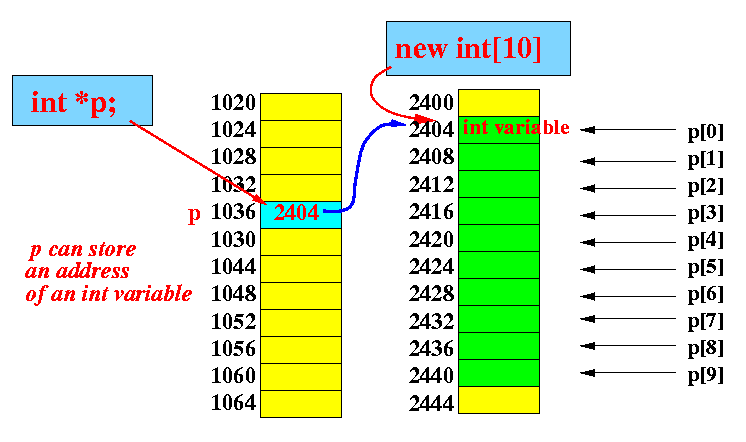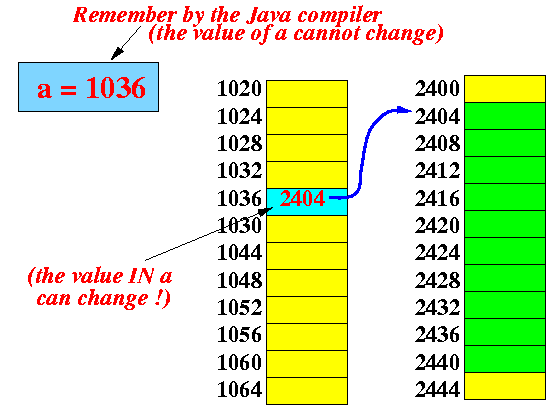- C++ has the
new operator that
is identical to
Java's own new operator
(So I don't need to spend much time explaining what it does.
I have explained new before, if you need a refresher, see: click here)
- Syntax of C++'s
new operator:
new TYPE // Allocate space to store ONE variable of // the type TYPE new TYPE [ N ] // Allocate space to store N variables of // the type TYPE - Just like in Java, the new in C++ returns the address of the reserved memory block
- The new
operator returns
an address
- A reference variable
can store an address
- Clearly, we must use
a reference variable
to store the address
returned by new
- Example:
int *p; // p can store an address int i; p = new int[10]; // We are using array notation with a pointer variable ! p[0] = 12; p[1] = 23; p[2] = 34; p[3] = 45; p[4] = 56; p[5] = 67; p[6] = 78; p[7] = 89; p[8] = 90; p[9] = 111; for ( i = 0; i < 10; i++ ) { cout << p[i] << " "; }
- Graphically, this data structure is created by the
above code:

- NOTE:
- The above data structure should look
familiar to you...
- It is the same way that
an array is stored in
Java !!!
- Example:
int[] a; a = new int[10];
results in:

- The above data structure should look
familiar to you...
- Unlike Java,
the C++ programming language
does not provide
a garbage collection system
to reclaim
garbage
- Recall that garbage is
an inaccessible variable
that was previous created by the
new operator.
Example:
ListElem p; p = new ListElem; Result:
p = new ListElem; // Overwrites p with a new address Result:
The first ListElem can no longer be accessed (because the location is "forgotten")
Such memory variable is known as garbage
- When a dynamically
created/allocated variable is
no longer used (needed),
you must de-allocate the
reserved memory using:
delete PointerVariable;Example:
ListElem p; p = new ListElem; // Allocate space for one ListElem variable ... delete p; // **** Deallocate space allocated !!!
- Arrays in Java is
dynamic
This means that the size of an array in Java can change during the program execution
- In contrast, Arrays in C++ is
static
This means that the size of an array in C++ cannot change during the program execution
- BUT....,
C++ does support
dynamic arrays using
pointer variables
- Example: double the size of an array
int i, N; int *p, *q; /* ------------------------------------ Make an array ------------------------------------ */ N = 10; p = new int[N]; // array of 10 elements for ( i = 0; i < N; i++ ) p[i] = i; /* ------------------------------------ Double the side of the array ------------------------------------ */ q = new int[2*N]; // array of 20 elements for ( i = 0; i < N; i++ ) q[i] = p[i]; // Copy old array to new array delete(p); // **** Remember to free unused space !!! p = q; // Switch p over to the new array N = 2*N; // Remember new array size
- Example Program:
(Demo above code)

- Prog file: click here
- The new operator in
C++ is just like the one in Java which
is used to
reserve unused memory
- But unlike Java,
the C++ programming language
does not have a
garbage collector
- Very very very Important fact:
- You must return the reserved memory obtained by new when the variable (memory) become unnecessary